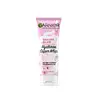What's inside
What's inside
 Key Ingredients
Key Ingredients

No key ingredients
 Benefits
Benefits

 Concerns
Concerns

 Ingredients Side-by-side
Ingredients Side-by-side

Water
Skin ConditioningSorbitol
HumectantLauric Acid
CleansingStearic Acid
CleansingMyristic Acid
CleansingPotassium Hydroxide
BufferingGlycol Distearate
EmollientPalmitic Acid
EmollientKaolin
AbrasiveSodium Cocoamphoacetate
CleansingCoco-Betaine
CleansingCI 14700
Cosmetic ColorantCI 16035
Cosmetic ColorantLinalool
PerfumingNiacinamide
SmoothingParfum
MaskingSodium Chloride
MaskingSodium Hyaluronate
HumectantSodium Palmitoyl Proline
Skin ConditioningSodium Benzoate
MaskingPhenoxyethanol
PreservativePrunus Yedoensis Leaf Extract
Skin ConditioningDisodium EDTA
Limonene
PerfumingAscorbyl Glucoside
AntioxidantNymphaea Alba Flower Extract
Skin ConditioningHydroxypropyl Methylcellulose
Emulsion StabilisingCitronellol
PerfumingCapryloyl Salicylic Acid
ExfoliatingDipropylene Glycol
HumectantPolyquaternium-7
Butylene Glycol
HumectantBenzyl Alcohol
PerfumingBenzyl Salicylate
PerfumingWater, Sorbitol, Lauric Acid, Stearic Acid, Myristic Acid, Potassium Hydroxide, Glycol Distearate, Palmitic Acid, Kaolin, Sodium Cocoamphoacetate, Coco-Betaine, CI 14700, CI 16035, Linalool, Niacinamide, Parfum, Sodium Chloride, Sodium Hyaluronate, Sodium Palmitoyl Proline, Sodium Benzoate, Phenoxyethanol, Prunus Yedoensis Leaf Extract, Disodium EDTA, Limonene, Ascorbyl Glucoside, Nymphaea Alba Flower Extract, Hydroxypropyl Methylcellulose, Citronellol, Capryloyl Salicylic Acid, Dipropylene Glycol, Polyquaternium-7, Butylene Glycol, Benzyl Alcohol, Benzyl Salicylate
Water
Skin ConditioningPentylene Glycol
Skin ConditioningPEG-7 Glyceryl Cocoate
EmulsifyingBenzotriazolyl Dodecyl P-Cresol
UV AbsorberAlpinia Katsumadai Seed Extract
Skin ConditioningAllantoin
Skin ConditioningMoringa Oleifera Seed Extract
Skin ConditioningGlycerin
HumectantSorbitol
HumectantButylene Glycol
HumectantSodium Lactate
BufferingDisodium Phosphate
BufferingDisodium EDTA
Polyaminopropyl Biguanide
PreservativePPG-5-Ceteth-20
EmulsifyingSodium Chloride
MaskingParfum
MaskingLactic Acid
BufferingCitric Acid
BufferingPEG-6 Caprylic/Capric Glycerides
EmulsifyingWater, Pentylene Glycol, PEG-7 Glyceryl Cocoate, Benzotriazolyl Dodecyl P-Cresol, Alpinia Katsumadai Seed Extract, Allantoin, Moringa Oleifera Seed Extract, Glycerin, Sorbitol, Butylene Glycol, Sodium Lactate, Disodium Phosphate, Disodium EDTA, Polyaminopropyl Biguanide, PPG-5-Ceteth-20, Sodium Chloride, Parfum, Lactic Acid, Citric Acid, PEG-6 Caprylic/Capric Glycerides
 Reviews
Reviews

Ingredients Explained
These ingredients are found in both products.
Ingredients higher up in an ingredient list are typically present in a larger amount.
Butylene Glycol (or BG) is used within cosmetic products for a few different reasons:
Overall, Butylene Glycol is a safe and well-rounded ingredient that works well with other ingredients.
Though this ingredient works well with most skin types, some people with sensitive skin may experience a reaction such as allergic rashes, closed comedones, or itchiness.
Learn more about Butylene GlycolDisodium EDTA plays a role in making products more stable by aiding other preservatives.
It is a chelating agent, meaning it neutralizes metal ions that may be found in a product.
Disodium EDTA is a salt of edetic acid and is found to be safe in cosmetic ingredients.
Learn more about Disodium EDTAParfum is a catch-all term for an ingredient or more that is used to give a scent to products.
Also called "fragrance", this ingredient can be a blend of hundreds of chemicals or plant oils. This means every product with "fragrance" or "parfum" in the ingredients list is a different mixture.
For instance, Habanolide is a proprietary trade name for a specific aroma chemical. When used as a fragrance ingredient in cosmetics, most aroma chemicals fall under the broad labeling category of “FRAGRANCE” or “PARFUM” according to EU and US regulations.
The term 'parfum' or 'fragrance' is not regulated in many countries. In many cases, it is up to the brand to define this term.
For instance, many brands choose to label themselves as "fragrance-free" because they are not using synthetic fragrances. However, their products may still contain ingredients such as essential oils that are considered a fragrance by INCI standards.
One example is Calendula flower extract. Calendula is an essential oil that still imparts a scent or 'fragrance'.
Depending on the blend, the ingredients in the mixture can cause allergies and sensitivities on the skin. Some ingredients that are known EU allergens include linalool and citronellol.
Parfum can also be used to mask or cover an unpleasant scent.
The bottom line is: not all fragrances/parfum/ingredients are created equally. If you are worried about fragrances, we recommend taking a closer look at an ingredient. And of course, we always recommend speaking with a professional.
Learn more about ParfumChances are, you eat sodium chloride every day. Sodium Chloride is also known as table salt.
This ingredient has many purposes in skincare: thickener, emulsifier, and exfoliator.
You'll most likely find this ingredient in cleansers where it is used to create a gel-like texture. As an emulsifier, it also prevents ingredients from separating.
There is much debate on whether this ingredient is comedogenic. The short answer - comedogenic ratings don't tell the whole story. Learn more about comegodenic ratings here.
The concensus about this ingredient causing acne seems to be divided. Research is needed to understand if this ingredient does cause acne.
Scrubs may use salt as the primary exfoliating ingredient.
Learn more about Sodium ChlorideSorbitol is a sugar alcohol. It is a hydrating and moisturizing agent created from the reduction process of glucose.
Most sorbitol is usually made from potato starch. It is also found in fruits such as apples and pears.
As a humectant, Sorbitol helps draw water to the skin. This helps keep the skin hydrated. Sorbitol also helps create a thicker texture in products. You might find sorbitol in your toothpaste and other gels.
It is a non-irritating ingredient that is great for those with dry skin.
Sorbitol is a prebiotic. It helps promote the growth of healthy bacteria on your skin. The bacteria on your skin form a microbiome. This microbiome helps protect your skin from infection and harmful bacteria.
Learn more about SorbitolWater. It's the most common cosmetic ingredient of all. You'll usually see it at the top of ingredient lists, meaning that it makes up the largest part of the product.
So why is it so popular? Water most often acts as a solvent - this means that it helps dissolve other ingredients into the formulation.
You'll also recognize water as that liquid we all need to stay alive. If you see this, drink a glass of water. Stay hydrated!
Learn more about Water